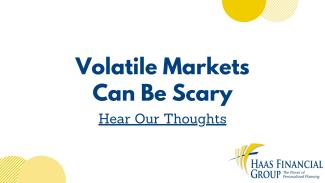
Volatile Markets Can Be Scary. Hear Our Thoughts.
In the last several weeks, we have continued to face rocky times in financial markets, so we thought it was an important time to take stock again as we move into the final quarter of 2022.
To be clear right off the bat, the intent in sharing these updates is not to sound any alarms. Rather, we know that even for long-term investors like you and me, these swings and losses can feel a bit unnerving. Even I need to remind myself of why we diversify and resist the urge to “jump ship” as they say. If you’re fine to trust the process and you’re not stressed by these short-term movements, know that we feel okay and promise to communicate directly if/when we feel we need to make adjustments.
If you want to get deeper in the weeds with us today, I am going to share a couple things we are reading and following, just as I did back in June and in May and March before that. So let’s start there. The predominant theme of 2022 has not really changed: Stock AND bond markets continue to struggle with more persistent than expected inflation. You undoubtedly feel it, not only as an investor but also as households and businesses. We are all navigating higher prices and borrowing costs and that certainly creates challenges for not just us as individuals, but for the whole economy.
The Federal Reserve (Fed) continues to raise interest rates to try to control that inflation and find some price stability again. It’s one of the few tools the Fed has to try to control inflation, but it’s not as though they can just turn a dial or flip a switch. There are a lot of factors that drive prices and inflation so a lot of uncertainty remains on how these rate increases will play out and over what period of time. There are also a lot of factors OUT of the Fed’s control and no real clarity around WHEN those factors may see some resolution
- We still have supply chain issues messing with the balance of supply and demand
- We still see a zero-Covid policy in China that further skews demand and production
- And we still have war in Ukraine that is sending ripples well-beyond the battlegrounds
The market hates uncertainty. And it’s trying to figure out how it will all play out. We know we have a Fed stating it is willing to do whatever it takes to reign in prices, which means deliberately slowing the growth of the US economy. Fact is, that could potentially induce a recession. Recession means lower expectations on corporate profits. Recession means lower stock prices.
Now, the market is NOT the economy, but being very forward looking, the market IS trying to make a prediction on whether the Fed can balance slowing the economy enough WITHOUT pushing us into a recession. I think you will hear arguments on both sides of whether they can pull that off for weeks to come. While that debate happens, the reality is we have to go through this period of uncertainty -
- Markets will react
- We expect volatility to remain
- Which probably means most asset classes will be challenged to rise in price, not just stocks.
- Bonds typically do poorly when there are ongoing interest rate hikes and rising inflation. We should expect that to the case this time too.
- Slowing economic growth can negatively impact corporate earnings, which as the main driver of prices means prices may continue to go down.
- And that's not just here in the US. International markets are faced with similar challenges and also continue to feel the effects of the Ukraine war and a stronger US dollar. So we can't hide there either.
It’s not comfortable. It’s not fun. But let me flip the script a bit though and share that I feel there is a positive spin I can reasonably put on all of this with some thoughts directly from Jeff Roach, Chief Economist with LPL Research:
- Inflation is decelerating. Gas prices and agricultural commodity prices, for example, have declined throughout this summer. Also, rends in some areas of the country are dropping, durable goods prices are declining, and many import prices are falling. When our central bankers are sufficiently convinced, the Fed can slow the pace of tightening as inflation moves closer to their long-run target. If the Fed shares that sentiment, stock prices should rebound.
- Investor Sentiment. Some of the recent market volatility came from mixed inflation signals, so as the signals become more aligned, we expect volatility will fall and investor sentiment will improve. The level of bearishness right now is very high, but it's important to remember that historically extreme negative sentiment has often been followed by strong market performance. To take just one example, the American Association of Individual Investors (AAII) as been doing a weekly survey since 1987. Last week's survey had a level of bearishness seen only four other times before. S&P 500 returns a year later in those cases averaged over 30%. We don't know whether that will happen again, but there's still an important takeaway. As we experienced in 2020, when a lot of negative sentiment is being priced into markets, it may set the bar low for stocks to outperform expectations.
- Timing. We also have some positive seasonal patterns ahead. November through April are historically strong months for equities. Stocks have also done well after mid-term elections. And the third year of the four-year presidential cycle (which we enter in 2023) has historically been the strongest for stocks.
Two final thoughts to be glass half-full on:
- Bond yields are up! Rising rates to combat inflation has its positives for income driven investors. For many years, bond investments weren't paying you a whole lot just to own them. Moving forward, that rise in rates certainly has the potential to increase which of course is a main objective for most retirees and their portfolio paychecks.
- And lastly - Recessions are unfortunately a NORMAL part of the business cycle. And as our new teammate, Mike, pointed out, recessions are not unlike forest fires. There is danger, there is harm. But forest fires can also help the environment too. Same for recessions. There is a natural cycle of destruction and recreation that is our economy. Recessions aren't desired, but they make room for new businesses to grow, for good businesses to continue to adapt, and sometimes that recovery and regrowth is rapid and leads to new highs.
So, despite the climate of doom and gloom, we continue to believe it’s important to remain invested, focus on long term investment goals, and not try to time markets. Is the worst over? No one knows.
But a key factor in investing is to remember that markets are always forward looking. Once the bad news is priced into the markets, they often unexpectedly rally well before fundamentals. Think back to the Covid rebound in 2020 and the rebound after the Great Recession of 2009: in both cases, we were still feeling that the economy may have been broken as markets had historic rallies for what may have seemed like no reason whatsoever. We can’t miss those recoveries! That’s why we believe the surest path forward remains sound financial planning and a steady hand during these times. Diversify. And stay invested. Because even if you don’t see a clear reason for the next market rally to take place, it might be just an economic report or two away.
https://lpl-research.com/~rss/LPL_RSS_Feeds_Publications/CL/Client_Letter_9282022.pdf
Tracking # T004577

